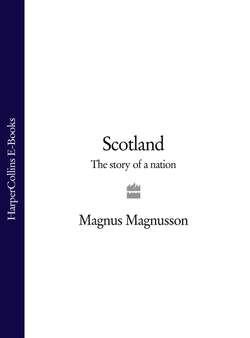Читать книгу Scotland: The Story of a Nation - Magnus Magnusson - Страница 30
Constantin II
ОглавлениеConstantin II was a remarkably long-lived king who was eventually to outlive his effectiveness. In his prime he fought against the vikings encroaching from the north and the west; but he was also determined to extend the boundaries of ‘Lesser Scotland’ southwards beyond the Forth – Clyde line. In 914, and again in 918, he made inconclusive forays as far south as Corbridge; but now the position in Northumbria was changing dramatically.
The old Anglian kingdom of Northumbria had been overwhelmed by the Norsemen, and King Alfred of Wessex (Alfred the Great) had been forced to partition England in 878, yielding to the Norsemen the huge swatch of east and north England which became known as the Danelaw. Alfred’s son (Edward the Elder of Wessex, r.899–924) and grandson (Athelstan, r.924–39) succeeded in turning the tide of Norse domination. By 920, Edward the Elder had won back all the Danelaw south of the Humber. The next target was York, and in 927 the vigorous young Athelstan expelled the Norsemen from their powerbase there and assumed the overlordship of Northumbria. Seven years later, in 934, Athelstan consolidated his position in the north of England with a sweeping invasion of Alba, backed by a fleet which harried the east coast as far north as Caithness.
The growing power of Wessex posed an obvious and alarming threat to the fledgling kingdom of Alba, which was also constantly menaced by the power of the Norse earls of Orkney and Shetland. In 937 Constantin II joined a Great Alliance of the Norsemen in Ireland and the Britons of Strathclyde for a pre-emptive strike against the West Saxons. Together they sailed and marched down to the Humber, a huge host, for a trial of strength with Athelstan. The two sides met at a place called Brunanburh, somewhere on Humberside, perhaps, in a ferocious battle which would be commemorated in contemporary poetry and folk memory as the bloodiest encounter yet fought on English soil:
Athelstan the king,
lord of earls
and ring-giver to men,
his brother beside him,
Edmund the Ætheling,
won undying glory
in furious battle
with the blades of their swords
at Brunanburh:
burst through the shield-wall,
hewed at the bucklers
with well-forged swords,
the sons of Edward …
FROM THE BATTLE OF BRUNANBURH,
IN THE ANGLO-SAXON CHRONICLE (937)
It was a decisive victory for Athelstan. Among the dead was one of Constantin’s sons. The defeat of all his hopes for his kingdom, and the death of his son, seem to have drained the spirit out of Constantin, and in 943 he abdicated and withdrew to monastic life in St Andrews. It was his successors who began to stem the seemingly irresistible Wessex advance. One of his sons, Indulph (r.954–62), managed to capture the formidable stronghold of Edinburgh and gain temporary control of Lothian. But it was not until the next century that the Scots, under the leadership of the forceful and ambitious Malcolm II (Mael Coluim mac Cinaeda, r.1005–34), finally succeeded in wresting control of the Lothians from Northumbria.
The decisive showdown occurred in 1018. Malcolm had already annexed the kingdom of Strathclyde and had shown his mettle with some merciless raids deep into Northumbria, including a siege of Durham on one occasion. The Northumbrians were outraged. They raised a huge army commanded by warrior prelates pledged to recover the Church lands (and revenues) of Lothian. Malcolm met them with his forces at Carham, just south of the Tweed. It was another fierce encounter, but this time the Scots won the day. Many of the English fell, including a score of Northumbrian nobles and eighteen leading churchmen.
One of the casualties on the Scottish side was Owain, who ruled Strathclyde as a vassal of the Scots. He was the last of his family line, and Malcolm now added the kingdom of Strathclyde (the Britons) to the Scottish realm.1
The significance of the Battle of Carham in 1018 was only to emerge later. It was the last battle for Scottish control of the Lothians. Carham marked the first firm delineation of a settled frontier between Scots and English along the line of the River Tweed; but it would be a very long time before this line was to emerge as an accepted final boundary. With the hindsight of history, we can see Carham as a real watershed in the evolution of the shape of ‘Scotland’ as we know it today.
